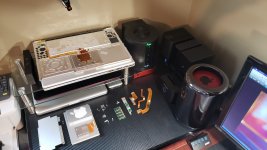- Joined
- Apr 20, 2009
- Messages
- 4,301
- Reaction score
- 124
- Points
- 63
- Location
- The lonely planet
- Your Mac's Specs
- Too many...
Good to see some responses on this thread. I bought the MBA 11" to miniaturize and be very mobile so I don't want to carry around many extra peripherals yet I already will be carrying 1 extra 1 TB external drive for CCC backups. I'm not looking to build anything as some said, I'm only looking to purchase the best possible and most compatible SSD for the MBA and it is not an OWC.
But from what I'm told, the MBA has its own controller (with no hard drive in it) so I guess the controller is on the motherboard, and an SSD has it's own controller built into its own PCB and if those 2 controllers aren't compatible with each other and don't handshake each other well then I won't be getting full 6 GB speeds but instead throttled-down half speeds of 3 GB or 1.5 GB.
So I'm asking which controllers are on Samsung, Crucial and Western Digital SSD's so I can make the right choice in my purchase. I don't want to choose an OWC for instance and use their terrible SandForce controller which gives me reduced 3 GB speeds and not the expected 6 GB speeds. I would like to use the full potential speed of the hard drive ofcourse, but this is only due to compatible controllers. I hope this made sense and we're on the same page.
Does anyone know the names of the controllers per aftermarket SSD so I can research their compatibility and speeds with the MBA?
You keep referring to Sandforce, but I don't think you really know much about what goes into these drives that you are looking at.
The OWC drive for your MBA is a Tier 1 MLC Sync-NAND drive running a Silicon Motion SM2246EN controller/processor. It's not Sandforce!!
The "oldschool" OWC Sandforce drives worked best on older SATA1/SATA2 Apple computers because it was best suited for the way OSX handled data at that time without TRIM. They were literally designed to work on Apple computers first. People stuck them in Windows computers and complained when the benefits didn't show. TRIM was not available at that time on Apple computers, so data loss prevention had to be handled by the SSD. This was due to the nature of SSDs and it being IMPOSSIBLE for an SSD to not have permanent block/data corruption over time. They all slowly get corrupted from constant data shuffling. The OWC drives have an allocated space to be used to replace corrupt blocks. Other SSDs from that time could not do this, and few to this day are capable of doing this due to the large proportion of SSDs reliance on TRIM to handle corruption.
I've had countless experiences with SSDs from many manufacturers. OWC is the first company I turn to for reliable data handling and consistent performance on an Apple computer- HANDS DOWN!. There will always be a tradeoff with SSDs. You can't get long term reliability without impacting performance. Speed, heat, and a change in voltage/current are killers for SSDs. That is why most "enterprise" SSDs have throttle management to enhance the life of an SSD, while "consumer" grade SSDs have nothing, and rely on TRIM or reserve storage bank to swap corrupted blocks with new ones.
There really aren't many players in the SSD world when you look under the skin of an SSD enclosure. Most are very similar architectures, with just tweaked operating parameters. Companies don't have great variances in cost. So if one SSD is cheaper, there is a reason. And I've learned that first hand. While you can experiment with adapters and what not to make a cheaper option work, in the end, you get what you paid for.
That OWC 1Tb blade is one of the best swap-in option for your MBA for long and consistent use. I would NEVER suggest running 1TB of SSD storage off of an adapter!! I'd only consider doing such a thing on a small drive that won't be handling much data.






